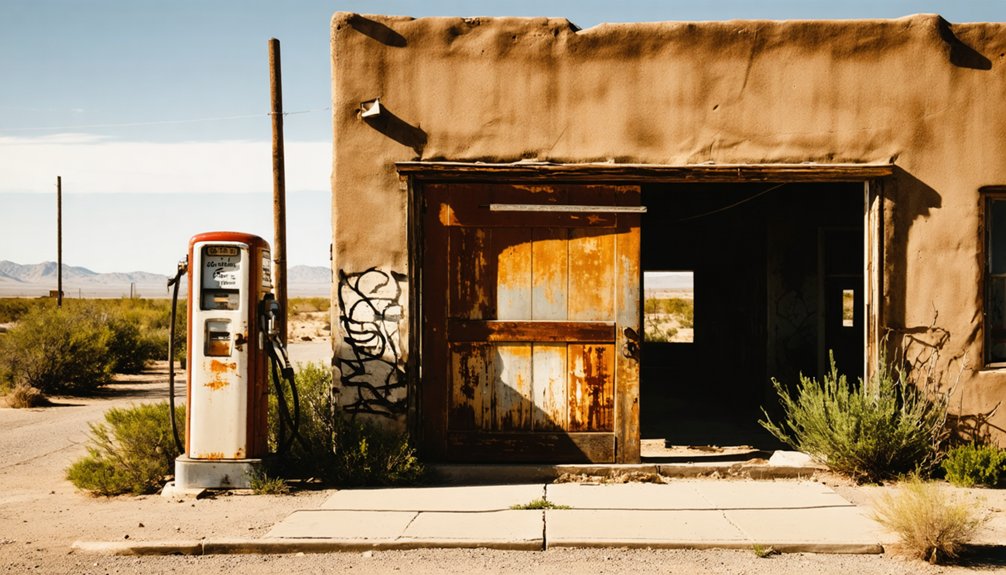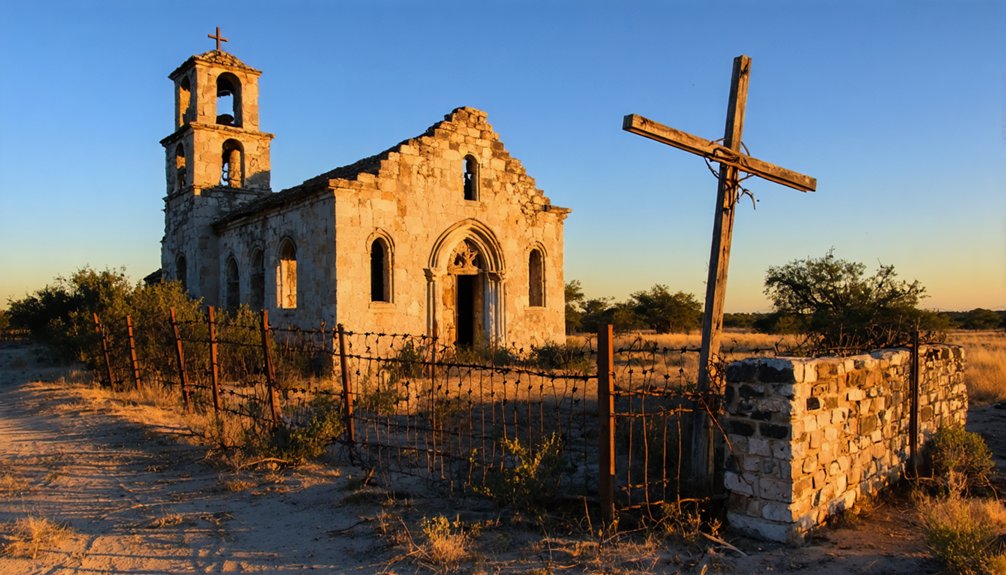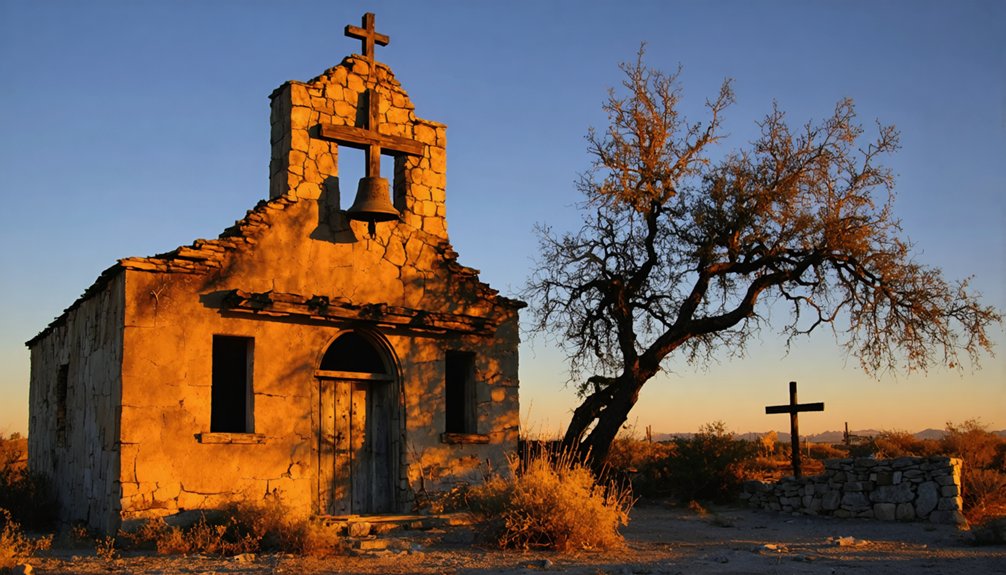You’ll find La Lomita Mission nestled in Texas’s Rio Grande Valley, where an 1899 stone chapel marks what was once a bustling frontier outpost. Originally established in the 1770s through Spanish land grants, this historic site evolved from a ranch into an essential spiritual center. Today, the chapel’s thick sandstone walls hold tales of supernatural encounters, with visitors reporting ghostly priests, mysterious footsteps, and unexplained phenomena that echo its rich past. The grounds still whisper secrets of the Valley’s transformation.
Key Takeaways
- La Lomita was a thriving mission settlement that transformed into a ghost town after selling 17,000 acres to developers in 1907.
- The site features a historic 1899 stone chapel with thick sandstone walls that remains standing amid the abandoned settlement.
- Supernatural phenomena reported include ghostly children’s cries, shadowy priest figures, unexplained temperature drops, and mysterious footsteps.
- The ghost town’s infrastructure once included a general store, blacksmith shop, and lodging facilities for travelers between Brownsville and Roma.
- La Lomita’s abandoned grounds influenced the founding of Mission, Texas, and remain a cultural landmark despite its ghost town status.
The Birth of La Lomita Mission
While Spanish land grants first established settlement in the area around 1770, La Lomita’s true birth as a mission began when French immigrant René Guyard purchased the ranch in 1845. The mission origins trace back to Guyard’s generous gift of the property to the Oblates of Mary Immaculate, who recognized the spiritual significance of this strategic location along the Rio Grande Valley.
You’ll find that by 1865, the Oblates had constructed their first adobe chapel and living quarters, transforming La Lomita into an essential stopover for their “Cavalry of Christ” missionary work. The site became an important point along the historic Oblate Trail that clergy used to reach communities throughout South Texas.
From this humble hilltop, priests rode out to serve scattered settlements throughout the region. The mission quickly became a beacon of faith, with its original buildings including simple pole-and-mud structures that housed both overseers and traveling priests. The chapel’s whitewashed sandstone walls were constructed nearly two feet thick, providing sturdy shelter from the elements.
From Ranch to Religious Center
When you visit La Lomita today, you’ll be walking the same grounds where Oblate priests struggled to make their 1884 ranch operation profitable through failed grape and potato ventures.
You can still see remnants of their early efforts, including the original pole-and-mud buildings that housed overseers and clergy during those challenging first years.
In 1907, they began a new chapter when they sold 17,000 acres to developers, forever changing the landscape of the region.
The Oblates’ determination to overcome agricultural setbacks led them to fence a large section with barbed wire in 1890, marking their commitment to transform the struggling ranch into what would become a thriving mission headquarters by 1899. The site later became home to Our Lady’s shrine, where the restored chapel continues to stand as a testament to its religious heritage.
Oblates Transform Ranch Life
In 1899, La Lomita ranch underwent a profound transformation as it became the residential headquarters for a new Oblate mission district overseeing 65 ranches throughout Hidalgo County.
You’ll find this shift marked by the construction of a stone chapel beside two jacales and later, a brick rectory for the priests. While farming ventures like grape and potato cultivation had failed despite barbed wire fencing, the Oblate presence brought new purpose to the land.
The “Cavalry of Christ” priests would ride out on horseback circuits spanning 100 miles, serving isolated ranch families across South Texas. The priests endured yellow fever epidemics while ministering to the faithful. Under the guidance of Father Bretault, these dedicated missionaries managed the Oblate ranch while serving the hardest missions in the region.
From La Lomita’s strategic mid-Valley location, they’d brave border conflicts, disease, and political turmoil to minister to scores of settlements, fundamentally reshaping ranch life through their dedicated service.
Early Agricultural Challenges
Despite its prime location along the Rio Grande, La Lomita Ranch struggled with early agricultural ventures throughout the 1890s. You’d have found a diverse array of crops being tested, from grapes to bananas, but crop failures became commonplace due to inadequate pest management and infrastructure.
Here’s what made farming so challenging at La Lomita:
- Birds and wildlife frequently ravaged the grapevines before harvest time
- The Rio Grande’s shifting course forced repeated rebuilding of settlements
- Limited irrigation systems prevented maximizing the fertile soil’s potential
- Remote management from Brownsville hindered effective oversight of operations
While the soil and climate could’ve supported thriving agriculture, these early setbacks demonstrated how the region’s evolution from ranching to farming required more than just good land – it needed proper infrastructure and local supervision. The area’s fortunes changed dramatically when John H. Shary rebuilt the irrigation system and introduced successful citrus farming operations.
Tales of the Supernatural
If you’re visiting La Lomita Chapel at dusk, you’ll hear what locals swear are the ghostly cries of children echoing across the old mission grounds.
You might encounter shadowy figures resembling Oblate priests gliding through the chapel’s stone walls, accompanied by unexplained temperature drops and whispered prayers in Spanish. These apparitions are said to be the spirits of the Cavalry of Christ who once rode between 65 ranches to minister to the faithful.
The chapel’s troubled history of floods and rebuilding seems to have left spiritual imprints, with visitors regularly reporting mysterious footsteps and moving objects within the sacred space. Local lore suggests the 1865 flood damage washed away more than just the original structure.
Haunted Chapel Encounters
While La Lomita Chapel stands as a historic monument to South Texas’ religious heritage, its walls harbor some of the region’s most chilling supernatural encounters.
You’ll find yourself immersed in a world where ghostly sightings of nuns suspended in prayer merge with spectral encounters of wandering priests, all tied to dark secrets from the chapel’s past.
- You might witness the infamous floating nun in daylight, known for appearing in prayer posture within the chapel’s main sanctuary.
- You’ll hear unexplained sounds echoing through the halls – from loud bangs to the unsettling cries of infants.
- You’ll feel an overwhelming dark energy, especially near the sealed rooms and basement areas.
- You’ll encounter shadowy figures of priests and nuns who allegedly broke their vows, their spirits forever bound to these sacred grounds.
The chapel’s isolation near the Rio Grande River made it an ideal location for concealing the dark events that would later fuel generations of ghost stories.
Ghostly Children’s Cries
Through the darkened corridors of La Lomita Chapel, you’ll encounter one of South Texas’ most haunting phenomena – the ghostly cries of children echoing across its sacred grounds.
These haunting melodies stem from a tragic past, where clergy members allegedly buried infants in the chapel’s field to conceal forbidden pregnancies.
You’ll find yourself amid reports of ghostly apparitions – children, floating nuns, and robed figures appearing even in broad daylight.
Security guards and visitors have fled in terror after hearing chains dragging across floors and babies wailing in empty rooms.
The chapel’s dark history of violence and secrecy continues to manifest through residual hauntings, where witnesses describe an oppressive energy that grips you upon entering.
These supernatural encounters have transformed La Lomita into a cautionary tale, keeping locals away after sunset.
Historic Architecture and Sacred Spaces
As La Lomita evolved from a frontier outpost into a spiritual center, its architectural heritage reflected the practical and sacred needs of South Texas settlers.
You’ll find architectural significance in the progression from simple jacales to the imposing 1912 brick novitiate, while sacred symbolism permeates every corner of this historic site.
- The original 1899 stone chapel, measuring 12 by 25 feet, anchored the community with its thick sandstone walls and distinctive belfry.
- Traditional building methods used local materials like native stone, lime-based mortar, and whitewashed finishes.
- The chapel’s interior featured box carpentry pews and a devotional space dedicated to Our Lady of Guadalupe.
- A functional quadrangle layout placed the chapel at the heart of community life, surrounded by essential structures like the cookhouse, store, and worker housing.
Economic Evolution and Urban Development

Once railroads and irrigation transformed the South Texas landscape in the early 1900s, La Lomita’s economic identity shifted dramatically from frontier ranching to urban development.
You’ll find that this economic change began when the Oblate Province sold 17,000 acres of ranch land to developers in 1907, keeping just 400 acres for mission use.
The strategic placement of the Missouri Pacific Railroad station four miles north of La Lomita sparked an urban migration that would seal the old settlement’s fate.
As the new town of Mission emerged on former Oblate lands, large-scale irrigation projects converted ranch land into profitable farmland.
Hidden Stories Behind Chapel Walls
While economic changes reshaped the broader La Lomita landscape, the chapel’s walls held deeper stories of faith, struggle, and community.
You’ll find hidden histories etched into every stone, carved from the very hill where it stands since 1899, after floods washed away its predecessor.
- The “Cavalry of Christ” rode through treacherous terrain to perform baptisms, marriages, and last rites for isolated ranching families.
- Chapel legends tell of determined Oblate missionaries who created a crucial stopover between Brownsville and Roma.
- Beyond religious services, the site housed a general store, blacksmith shop, and lodging for weary travelers.
- Mexican families lived and worked nearby, making the chapel the heart of a thriving multicultural community that relied on its wells and shelter.
Legacy in the Rio Grande Valley

Today, the legacy of La Lomita echoes powerfully through the Rio Grande Valley, where its influence shaped both the physical and cultural landscape.
You’ll find its most visible impact in the city of Mission, Texas, which was built entirely on former mission lands and proudly bears its name.
Beyond the physical landscape, La Lomita’s cultural impact resonates through generations of Valley residents. The chapel, now a cherished historic landmark, continues to draw community gatherings and serves as a spiritual beacon.
From its humble beginnings as a missionary outpost, the site catalyzed remarkable transformations – from vast ranchlands to fertile farmlands, from scattered settlements to thriving communities.
The Oblate missionaries’ vision lives on through Oblate Park and Our Lady of Guadalupe parish, evidence of their enduring commitment to the region’s spiritual and social development.
Frequently Asked Questions
What Happened to the Original Mexican Families Who Lived on La Lomita Ranch?
You’ll find your family heritage reshaped when Mexican families dispersed after the 1907 land sale, with some moving to Mission’s new town while others preserved their cultural legacy elsewhere in the valley.
Are Religious Services Still Held Regularly at La Lomita Chapel Today?
Like a steadfast beacon of faith, you’ll find regular services still held at La Lomita Chapel today, where Father Roy Snipes leads Friday morning masses and annual processions draw thousands of devoted worshippers.
How Did La Lomita Survive Major Floods Along the Rio Grande?
You’ll find La Lomita’s flood resilience stems from its inland position, sturdy adobe construction, and historical adaptations like natural levees. The chapel’s elevated location has protected it through major Rio Grande floods.
What Items From the Original 1865 Mission Still Exist Today?
Like scattered breadcrumbs of time, you’ll find few remnants from 1865. Historical artifacts in displays and stone materials quarried from La Lomita hill are all that remain – no original architectural features survive.
Which Native American Tribes Inhabited the Area Before La Lomita’s Establishment?
You’ll find that the Coahuiltecans were the primary Native American tribe here, comprising over 200 related groups who lived along both sides of the Rio Grande, sustaining themselves through hunting and gathering.
References
- https://www.youtube.com/watch?v=wc5cv-xSS_w
- https://ost.edu/la-lomita-mission-made-mission-texas/
- https://www.tshaonline.org/handbook/entries/la-lomita-mission
- https://www.youtube.com/watch?v=aqFhvghuLGc
- https://exploretexas.blog/2017/12/31/la-lomita-chapel/
- https://www.texasescapes.com/SouthTexasTowns/La-Lomita.htm
- https://colfa.utsa.edu/_documents/car/sr-000/sr-no-30.pdf
- https://utrgv.libguides.com/SCA/lalomita
- https://txssdac.org/la-lomita-mission.html
- https://www.olgmissiontx.org/about-us/history



